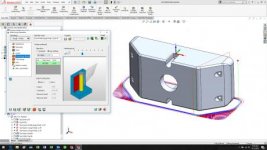Hello,
I'm looking to replace soon my MiniMill with a Brother Speedio. I was told that is very important watch for the downforce generated by large / long end mills, using HSM tool paths, so it's better to make steps, instead using the full cutting length.
As an example, I'm sharing 2 screen-shots from the same part with two different scenarios. Notice that everything is in metric, at exception the end mill diameter (5/8").
Picture 1: Using the all the cutter length, higher feed, and lower engagement.
Picture 2: Using 3 steps, lower feed, and higher engagement.
Is there an easy way to estimate the downforce generated in each case? What option do you think it will be safer? Do you think is possible to have the enough downforce, to pull the tool holder out of the spindle?
Just trying to change the 'chip' from 40 taper, and be able to use the Brother the safest way possible. The good thing is that I don't run very often this type of parts, so I'm not concerned about cycle time. Safety first.
Thanks,
Ricardo


I'm looking to replace soon my MiniMill with a Brother Speedio. I was told that is very important watch for the downforce generated by large / long end mills, using HSM tool paths, so it's better to make steps, instead using the full cutting length.
As an example, I'm sharing 2 screen-shots from the same part with two different scenarios. Notice that everything is in metric, at exception the end mill diameter (5/8").
Picture 1: Using the all the cutter length, higher feed, and lower engagement.
Picture 2: Using 3 steps, lower feed, and higher engagement.
Is there an easy way to estimate the downforce generated in each case? What option do you think it will be safer? Do you think is possible to have the enough downforce, to pull the tool holder out of the spindle?
Just trying to change the 'chip' from 40 taper, and be able to use the Brother the safest way possible. The good thing is that I don't run very often this type of parts, so I'm not concerned about cycle time. Safety first.
Thanks,
Ricardo



